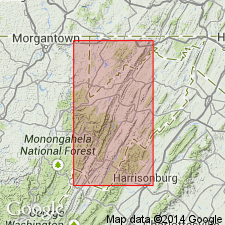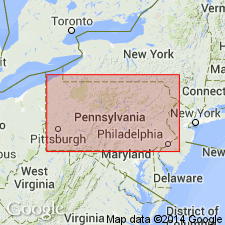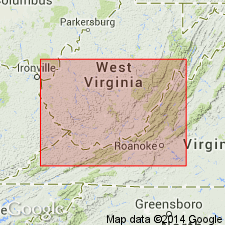
- Usage in publication:
-
- Briery Gap Sandstone Member
- Modifications:
-
- Named
- Dominant lithology:
-
- Sandstone
- AAPG geologic province:
-
- Appalachian basin
Summary:
Briery Gap Sandstone Member here named for stream on the Circleville 15-min quad. and assigned to the newly named Foreknobs Formation (Greenland Gap Group). Unit is massive, medium-grained to conglomeratic, fairly well-sorted, cross-bedded, yellowish gray weathering sandstone with very little interbedded siltstone and shale. Sandstones in VA are not as massive as those in WV and MD, and contain more interbedded siltstone, thus Rte 250 in VA may represent the southernmost recognizable extent of the Briery Gap. Probably formed by winnowing removal of fine clastic materials, leaving a near-shore deposit of clean sand. Unit is 118 ft (36 m) thick at type. Underlies Blizzard Member of Foreknobs; overlies basal Mallow Member of Foreknobs. Age is Late Devonian.
Source: GNU records (USGS DDS-6; Reston GNULEX).

- Usage in publication:
-
- Briery Gap Member
- Modifications:
-
- Areal extent
- AAPG geologic province:
-
- Appalachian basin
Summary:
In south-central PA, the Minnehaha Springs Member of the Scherr Formation and the Mallow, Briery Gap, Blizzard, Pound, and Red Lick Members of the Foreknobs Formation of the Greenland Gap Group are recognized. Briery Gap is composed of gray, massive, fine- to medium-grained, locally conglomeratic sandstone with minor siltstone and shale. Commonly contains CYRTOSPIRIFER CHEMUNGENSIS, CYRTOSPIRIFER INERMIS, AND "CAMAROTOECHIA" sp. Fossil community, ripple marks, and planar cross-bedding indicate that this member was deposited in delta front and shallow shelf environments.
Source: GNU records (USGS DDS-6; Reston GNULEX).

- Usage in publication:
-
- Briery Gap Sandstone Member
- Modifications:
-
- Areal extent
- AAPG geologic province:
-
- Appalachian basin
Summary:
The term Foreknobs Formation is not used in the stratigraphic cross section south of Gap Mills, WV. Arbitrary cutoffs are drawn where diagnostic characteristics are lost by facies change. The Mallow Member coarsens upward and also becomes finer grained toward the southwest. Cutoffs of the base of the Mallow Member are drawn between Alleghany and White Sulphur Springs. All sandstone in the Mallow, Briery Gap, Blizzard, and Pound Members is lost southwest of White Sulphur Springs resulting in an arbitrary cutoff of the base of the Foreknobs, which jumps up to the base of the Red Lick Member near Gap Mills. The Red Lick then loses all of its sandstone between Gap Mills and Bluefield.
Source: GNU records (USGS DDS-6; Reston GNULEX).
For more information, please contact Nancy Stamm, Geologic Names Committee Secretary.
Asterisk (*) indicates published by U.S. Geological Survey authors.
"No current usage" (†) implies that a name has been abandoned or has fallen into disuse. Former usage and, if known, replacement name given in parentheses ( ).
Slash (/) indicates name conflicts with nomenclatural guidelines (CSN, 1933; ACSN, 1961, 1970; NACSN, 1983, 2005, 2021). May be explained within brackets ([ ]).

